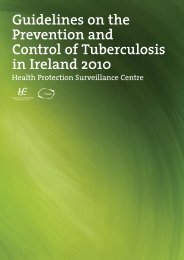Guidelines for the Early Clinical and Public Health Management of ...
Guidelines for the Early Clinical and Public Health Management of ...
Guidelines for the Early Clinical and Public Health Management of ...
You also want an ePaper? Increase the reach of your titles
YUMPU automatically turns print PDFs into web optimized ePapers that Google loves.
<strong>Guidelines</strong> <strong>for</strong> <strong>the</strong> <strong>Early</strong> <strong>Clinical</strong> <strong>and</strong> <strong>Public</strong> <strong>Health</strong> <strong>Management</strong> <strong>of</strong> Bacterial Meningitis (including Meningococcal Disease)<br />
<strong>the</strong> early stage <strong>of</strong> development <strong>the</strong> rash may blanch with pressure thus resembling a viral rash. The rash can appear<br />
rapidly on any part <strong>of</strong> <strong>the</strong> body including <strong>the</strong> palms <strong>and</strong> soles. The petechial rash presents as discrete 1 to 2 mm in<br />
diameter lesions that may proceed to <strong>for</strong>m larger ecchymotic lesions. The rash commonly appears in clusters in areas<br />
where pressure occurs from elastic in underwear <strong>and</strong> stockings. The rash may go unnoticed unless <strong>the</strong> acutely unwell<br />
patient with a systemic febrile illness is completely undressed so that a thorough search <strong>for</strong> a haemorrhagic rash can<br />
be undertaken.<br />
Less commonly, <strong>the</strong> rash has a maculopapular appearance, with <strong>the</strong> discrete pink macules or papules blanching<br />
under pressure. They may progress to become haemorrhagic <strong>and</strong> nonblanching later or fade away. 10<br />
Additional features that should alert clinicians to <strong>the</strong> possibility <strong>of</strong> meningococcal infection include:<br />
• an unwillingness to interact or make eye contact<br />
• an altered mental state, or<br />
• pallor despite a high temperature. 11<br />
A UK study published in 2006 12 reported on <strong>the</strong> variety <strong>of</strong> clinical presentations found among children under 16<br />
years <strong>of</strong> age diagnosed with meningococcal disease. The authors found that:<br />
• leg pain<br />
• cold extremities<br />
• <strong>and</strong> abnormal skin colour<br />
were frequently seen in <strong>the</strong> first 12 hours <strong>of</strong> meningococcal disease (median onset 7-12 hours).<br />
More recently in 2011 <strong>the</strong> authors reported five “red flag symptoms”:<br />
• confusion<br />
• leg pain<br />
• photophobia<br />
• rash <strong>and</strong><br />
• neck pain/stiffness.<br />
In this study cold h<strong>and</strong>s <strong>and</strong> feet had limited diagnostic value, while headache, <strong>and</strong> pale colour did not discriminate<br />
meningococcal disease in children. 13<br />
In contrast, <strong>the</strong> classic clinical features:<br />
• haemorrhagic rash<br />
• meningism, <strong>and</strong><br />
• impaired consciousness were<br />
relatively late signs (median onset 13-22 hours). 12,14<br />
These early features should <strong>the</strong>re<strong>for</strong>e be sought to aid <strong>the</strong> early recognition <strong>of</strong> invasive meningococcal disease in<br />
children less than 16 years <strong>of</strong> age. These symptoms <strong>and</strong> signs however, can be non-specific <strong>and</strong> some may be present<br />
with o<strong>the</strong>r bacterial <strong>and</strong> viral infections including self-limiting viral illnesses.<br />
• Doctors should be encouraged to review <strong>the</strong> situation within 4–6 hours if early meningococcal disease<br />
cannot be ruled out at <strong>the</strong> first assessment. 12,14<br />
If a GP decides that a patient with a non-specific febrile illness does not require referral to a hospital, <strong>the</strong> GP<br />
should advise <strong>the</strong> carer to keep <strong>the</strong> patient under frequent <strong>and</strong> regular review. Any deterioration or development<br />
<strong>of</strong> rash should trigger contacting <strong>the</strong> GP again or going immediately to a hospital emergency department. Rarely,<br />
meningococcal disease may present as conjunctivitis. Primary meningococcal conjunctivitis may be associated with<br />
invasive disease <strong>and</strong> should be treated systemically. 15<br />
2.3 <strong>Early</strong> antibiotic treatment <strong>for</strong> suspected bacterial septicaemia/meningitis<br />
It is imperative that antibiotic <strong>the</strong>rapy be commenced early if deaths from meningococcal septicaemia are to be<br />
avoided. Immediate administration <strong>of</strong> benzylpenicillin to suspected cases <strong>of</strong> meningococcal septicaemia by general<br />
practitioners was associated with reduced mortality in three retrospective studies in Engl<strong>and</strong>. 10,14,16 When <strong>the</strong><br />
studies were aggregated (487 patients), it was calculated that those not given parenteral penicillin be<strong>for</strong>e hospital<br />
admission were twice as likely to die than those given penicillin. 17 The greatest benefit <strong>of</strong> parenteral penicillin was<br />
seen in those who were most ill i.e. those with a haemorrhagic rash. 14<br />
-18-

















